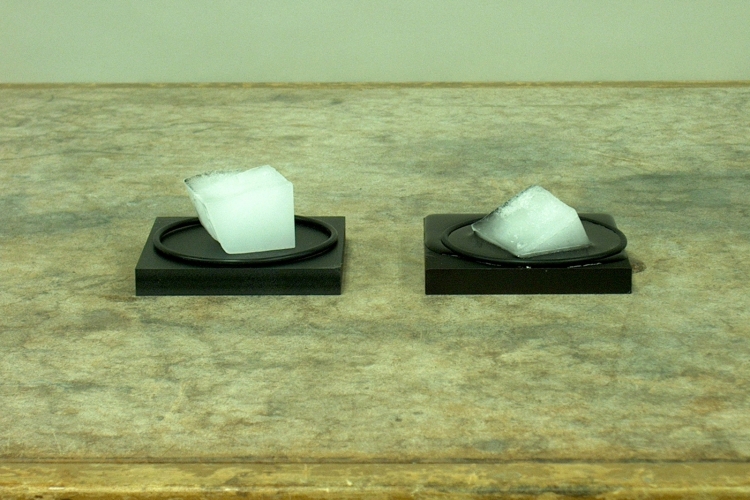
The photograph above shows a pair of plates that look identical. They are both black, and both have the same dimensions. The photograph shows them perhaps about one minute after an ice cube was placed on each plate. Each ice cube was about the same size as the other at the start. The one on the right is more than half melted, while the one on the left is still mostly frozen. The plates, then, are hardly identical.
In fact, the plate on the left is made of a rigid plastic foam, and the plate on the right is made of aluminum. (The o-rings are there to contain the water from the melting ice, though the one at right is being breached.) As described in demonstration 52.09 -- Heat conduction in various metal rods, the rate at which heat flows through a material depends on the thermal conductivity of that material. When we place an ice cube on each block, we set up a temperature gradient between the face on which the ice cube rests and the face that is on the table (and also the edges). The aluminum plate is a very good thermal conductor, and heat readily flows into the plate from the bottom and the edges, towards the top face, where it melts the ice cube. The plastic foam, however, is a very poor thermal conductor, and heat takes a very long time to flow through it. Thus, during the time it takes for the ice cube sitting on the aluminum plate to melt, very little happens to the ice cube that is on the plastic foam. (The plastic foam is such a poor conductor, in fact, that we might rightly consider it to be a thermal insulator.)
This demonstration offers another interesting and important aspect, which is to illustrate how these two materials differ to the touch. This may be difficult to do with large classes, but the idea is for students to touch each plate. Both plates are at room temperature, so they are significantly colder than a person’s hands. The plastic one, which conducts heat very poorly, allows heat to flow from the hand at such a low rate that it feels neutral or slightly warm to the touch. The aluminum, which is a very good thermal conductor, allows heat to flow very quickly out of the hand, and it feels cold to the touch. So when you perform the demonstration, the ice cube sitting on the “warm” block remains mostly frozen for a long time, while the ice cube on the “cold” block melts very quickly. (It might be helpful to have multiple sets of these plates for passing around, but there would have to be a good way of making a definite connection between the “warm” plate and the one on which the ice remains frozen, and the “cold” plate and the one on which the ice instantly begins to melt.) If it is not possible to do this part of the demonstration, a good illustration of this point would be the common experience that when we pull a can of soda out of the refrigerator, it feels significantly colder to the touch than does a plastic bottle of soda or a carton of juice or milk, even though all are at the same temperature (assuming that they all have had sufficient time to reach equilibrium with the inside of the refrigerator).